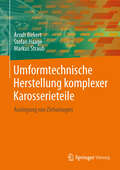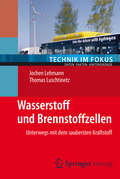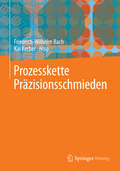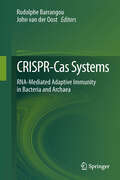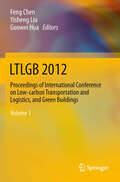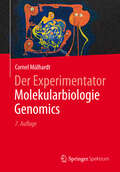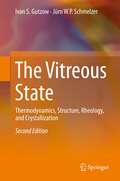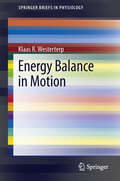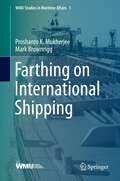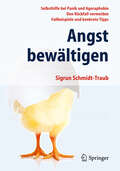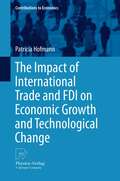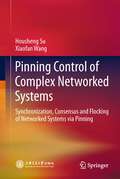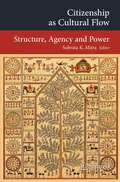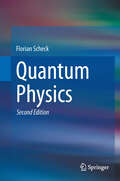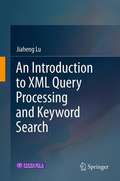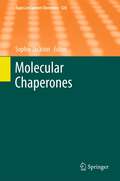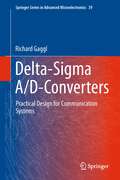- Table View
- List View
Real-Time C++: Efficient Object-Oriented and Template Microcontroller Programming
by Christopher Michael KormanyosThe C++ language has powerful object-oriented and template features that can improve software design and portability while simultaneously reducing code complexity and the risk of error. Furthermore, C++ compiles highly efficient native code. This unique and effective combination makes C++ well-suited for programming microcontroller systems that require compact size, high performance and safety-critical reliability.With this book, Chris Kormanyos delivers a highly practical guide to programming real-time embedded microcontroller systems in C++. It is divided into three parts plus several appendices. Part I provides a foundation for real-time C++ by covering language technologies, including object-oriented methods, template programming and optimization. Next, part II presents detailed descriptions of a variety of C++ components that are widely used in microcontroller programming. It details some of C++’s most powerful language elements, such as class types, templates and the STL, to develop components for microcontroller register access, low-level drivers, custom memory management, embedded containers, multitasking, etc. Finally, part III describes mathematical methods and generic utilities that can be employed to solve recurring problems in real-time C++. The appendices include a brief C++ language tutorial, information on the real-time C++ development environment and instructions for building GNU GCC cross-compilers and a microcontroller circuit.The most recent specification of C++11 in ISO/IEC 14882:2011 is used throughout the text. To facilitate portability, no libraries other than those specified in the language standard itself are used. Efficiency is always in focus and numerous examples are backed up with real-time performance measurements and size analyses that quantify the true costs of the code down to the very last byte and microsecond.The target audience of this book mainly consists of students and professionals interested in real-time C++. Readers should be familiar with C or another programming language and will benefit most if they have had some previous experience with microcontroller electronics and the performance and size issues prevalent in embedded systems programming.
Innovation Management in Knowledge Intensive Business Services in China
by Shunzhong LiuIn a knowledge-based economy, the development of a particular type of services, knowledge intensive business services (KIBS), becomes one of the characteristic trends in economic evolution. Current research focuses mainly on service innovation in developed countries, but little consideration is given to the situation in developing countries. Based on empirical research in the People's Republic of China, this book aims to contribute to a better appreciation and understanding of the innovative characteristics of KIBSs in developing countries.
AE-Manual der Endoprothetik: Ellenbogen
by Wolfgang Rüther Beat R. SimmenDer Band zur Endoprothetik des Ellenbogens ist der vorläufig letzte Teil des Gesamtwerkes Manual der Endoprothetik, herausgegeben von der Arbeitsgemeinschaft Endoprothetik Der prothetische Ersatz des Ellenbogengelenkes ist der am seltensten durchgeführte Gelenkersatz der großen Gelenke an oberen und unteren Extremitäten. Die funktionellen Kompensationsmöglichkeiten der Patienten, der weniger weit fortgeschrittene Entwicklungsstand der Ellenbogenprothetik im Vergleich zur Hüft- und Kniearthroplastik, die technischen Probleme bei der Operation selbst mit höherer Komplikationsrate und den äußerst anspruchsvollen Rückzugsmöglichkeiten beim Versagen sind die Ursachen. Dies gilt für alle bisher vorgestellten Designvariationen der Ellenbogenkunstgelenke. Gründe für das frühere und häufigere Versagen liegen in der besonderen Anatomie und Biomechanik des Ellenbogengelenkes und den damit verbundenen Konsequenzen für die Leistungsfähigkeit eines Kunstgelenkes. Auf diese Probleme wird in diesem Band eingegangen. Indikationsstellung, Operationstechnik, alternative Verfahren, frühe und späte Komplikationen, deren Behandlung, und Rückzugsmöglichkeiten werden dargelegt. Mittel- und längerfristige Ergebnisse werden diskutiert. Die beschränkten ossären Reserven des Ellenbogenknochenlagers, die Klippen und Tücken der Ellenbogenarthroplastik werden ersichtlich und mögen sowohl Anleitung sein als auch die Möglichkeiten und ihre Grenzen aufzeigen. Empfehlungen zur postoperativen Nachbehandlung und Rehabilitation ergänzen den Band Nationale und internationale Erfahrungen sind zu dieser Standortbestimmung zusammengeführt.
Umformtechnische Herstellung komplexer Karosserieteile
by Arndt Birkert Stefan Haage Markus StraubAn komplexe Karosserie-Blechformteile werden seitens der Automobilindustrie allerh#65533;chste Anforderungen hinsichtlich Funktionalit#65533;t und Oberfl#65533;chenqualit#65533;t gestellt. Um diese Anforderungen zu erf#65533;llen, wird ein entsprechender Methodenplan entwickelt. Das geplante Werk f#65533;hrt zun#65533;chst in Grundlagen von Karosseriebau, Umform- und Werkstofftechnik, Werkzeugtechnik und Pressentechnik ein, soweit diese f#65533;r die Herstellung von Karosserieteilen relevant sind. Auf Basis dieser Grundlagen wird im Hauptteil die Thematik der Methodenplanung behandelt, wobei der komplexe Planungsprozess zun#65533;chst auf ein sequentielles Gedankenmodell herunter gebrochen wird. Schlie#65533;lich wird anhand von Praxisbeispielen aufgezeigt, wie die zuvor sequentiell behandelten Planungsschritte zum Teil gleichzeitig, zum Teil nacheinander in mehreren Iterationsschleifen in der Praxis abgearbeitet werden. Bei allen Ausf#65533;hrungen steht stets die Erf#65533;llung der qualit#65533;tsm#65533;#65533;igen Anforderungen, die heute an moderne Karosserieteile gestellt werden, im Vordergrund.
Umformtechnische Herstellung komplexer Karosserieteile: Auslegung von Ziehanlagen
by Arndt Birkert Stefan Haage Markus StraubAn komplexe Karosserie-Blechformteile werden seitens der Automobilindustrie allerhöchste Anforderungen hinsichtlich Funktionalität und Oberflächenqualität gestellt. Um diese Anforderungen zu erfüllen, wird ein entsprechender Methodenplan entwickelt. Das geplante Werk führt zunächst in Grundlagen von Karosseriebau, Umform- und Werkstofftechnik, Werkzeugtechnik und Pressentechnik ein, soweit diese für die Herstellung von Karosserieteilen relevant sind. Auf Basis dieser Grundlagen wird im Hauptteil die Thematik der Methodenplanung behandelt, wobei der komplexe Planungsprozess zunächst auf ein sequentielles Gedankenmodell herunter gebrochen wird. Schließlich wird anhand von Praxisbeispielen aufgezeigt, wie die zuvor sequentiell behandelten Planungsschritte zum Teil gleichzeitig, zum Teil nacheinander in mehreren Iterationsschleifen in der Praxis abgearbeitet werden. Bei allen Ausführungen steht stets die Erfüllung der qualitätsmäßigen Anforderungen, die heute an moderne Karosserieteile gestellt werden, im Vordergrund.
Wasserstoff und Brennstoffzellen
by Jochen Lehmann Thomas LuschtinetzWarum ist Wasserstoff ein Energietr#65533;ger? Wie funktionieren Brennstoffzellen? Wie setzen wir Wasserstoff in den k#65533;nftigen Fahrzeugen ein? Wie sicher ist die Technik? Das kompakte Buch beschreibt verst#65533;ndlich die physikalischen und chemischen Grundlagen der Wasserstofftechnologie und erl#65533;utert die zu erwartenden technischen L#65533;sungen. Es stellt die Probleme dar und erm#65533;glicht, die Anstrengungen von Industrie und Forschung zur breiten Einf#65533;hrung dieser Technik besser zu verstehen. Die Autoren erkl#65533;ren anschaulich die Funktionsweise der wichtigsten Komponenten in der Wandlungskette vom regenerativen Strom zum Fahrzeugantrieb und zeigen deren technische Entwicklungspotenziale auf. Unter Ber#65533;cksichtigung der Zuverl#65533;ssigkeit und Wirtschaftlichkeit bewerten sie die mit dem Energietr#65533;ger Wasserstoff realisierbare Nachhaltigkeit des Energiekreislaufs.
Wasserstoff und Brennstoffzellen: Unterwegs mit dem saubersten Kraftstoff (Technik im Fokus)
by Jochen Lehmann Thomas LuschtinetzWarum ist Wasserstoff ein Energieträger? Wie funktionieren Brennstoffzellen? Wie setzen wir Wasserstoff in den künftigen Fahrzeugen ein? Wie sicher ist die Technik?Das kompakte Buch beschreibt verständlich die physikalischen und chemischen Grundlagen der Wasserstofftechnologie und erläutert die zu erwartenden technischen Lösungen. Es stellt die Probleme dar und ermöglicht, die Anstrengungen von Industrie und Forschung zur breiten Einführung dieser Technik besser zu verstehen.Die Autoren erklären anschaulich die Funktionsweise der wichtigsten Komponenten in der Wandlungskette vom regenerativen Strom zum Fahrzeugantrieb und zeigen deren technische Entwicklungspotenziale auf. Unter Berücksichtigung der Zuverlässigkeit und Wirtschaftlichkeit bewerten sie die mit dem Energieträger Wasserstoff realisierbare Nachhaltigkeit des Energiekreislaufs.
Prozesskette Präzisionsschmieden
by Friedrich-Wilhelm Bach Kai KerberSignifikante Potenziale zur Optimierung der Produktqualit#65533;t und Effizienz k#65533;nnen bei etablierten Fertigungsverfahren nur erkannt werden, wenn der gesamte Herstellungsprozess sowohl unter technologischen als auch unter logistischen Gesichtspunkten untersucht wird. Um nachhaltige Erfolge zu erzielen m#65533;ssen radikale Ver#65533;nderungen der Prozesskette, wie beispielsweise der Einsatz von innovativen und wirtschaftlich risikoreichen Fertigungsverfahren oder die vollst#65533;ndige Umgestaltung der bekannten Prozessketten, in Betracht gezogen werden. Durch prozess#65533;bergreifend abgestimmte technologische sowie logistische Ma#65533;nahmen k#65533;nnen so bisher unbekannte und ungenutzte Optimierungspotenziale auch bei etablierten und hochgradig optimierten Einzelprozessen gewinnbringend genutzt werden. Vor diesem Hintergrund besch#65533;ftigt sich das vorliegende Werk mit der Vorstellung und detaillierten Untersuchung der Prozesskette zur Herstellung von pr#65533;zisionsgeschmiedeten Hochleistungsbauteilen, sowohl unter technologischen als auch logistischen Aspekten. F#65533;r die Einzelprozesse der Prozesskette wird der aktuelle Stand der Forschung und Technik beschrieben und darauf aufbauend eine prozess#65533;bergreifende Technologieentwicklung vorgestellt.
CRISPR-Cas Systems: RNA-mediated Adaptive Immunity in Bacteria and Archaea
by Rodolphe Barrangou and John van der OostCRISPR/Cas is a recently described defense system that protects bacteria and archaea against invasion by mobile genetic elements such as viruses and plasmids. A wide spectrum of distinct CRISPR/Cas systems has been identified in at least half of the available prokaryotic genomes. On-going structural and functional analyses have resulted in a far greater insight into the functions and possible applications of these systems, although many secrets remain to be discovered. In this book, experts summarize the state of the art in this exciting field.
LTLGB 2012
by Feng Chen Guowei Hua Yisheng LiuThe LTLGB 2012 conference is intended to bring together researchers and related government officials involved in low carbon transportation, low carbon logistics and green building, industrial practitioners to present, discuss and exchange ideas, results and experiences in the area of low carbon transportation, low carbon logistics and green building and interdisciplinary applications.
Autonomous Sensor Networks: Collective Sensing Strategies for Analytical Purposes (Springer Series on Chemical Sensors and Biosensors #13)
by Daniel FilippiniThis volume surveys recent research on autonomous sensor networks from the perspective of enabling technologies that support medical, environmental and military applications. State of the art, as well as emerging concepts in wireless sensor networks, body area networks and ambient assisted living introduce the reader to the field, while subsequent chapters deal in depth with established and related technologies, which render their implementation possible. These range from smart textiles and printed electronic devices to implanted devices and specialized packaging, including the most relevant technological features. The last four chapters are devoted to customization, implementation difficulties and outlook for these technologies in specific applications.
Der Experimentator Molekularbiologie / Genomics
by Cornel MülhardtDieses Buch enthält das Grundlagenwissen sowie Tipps und Tricks für den Umgang mit Nucleinsäuren. Der Autor kennt Lust und Frust der täglichen Laborroutine ganz genau. Präparieren, Fällen, Konzentrieren und Reinigen von NucleinsäurenRestriktionsenzyme, Gele, BlottenPolymerase-KettenreaktionRNA-Isolierung, -TranskriptionKlonierung von DNA-FragmentenMarkierung von Sonden, Hybridisierung, Screening, SequenzierungMutagenese, In-vitro-Translation, transgene Mäuse, Transgenexpression, Gentherapie, GenomikDieses Buch richtet sich an alle Experimentatoren, die molekularbiologische Versuche durchführen wollen und gern nachvollziehen möchten, was sich in ihrem Reaktionsgefäß abspielt. Das ganze Spektrum der üblichen molekularbiologischen Methoden wird vorgestellt, kommentiert und Alternativen aufgezeigt. Der lockere Ton wendet sich gleichermaßen an Studenten wie an BTAs und Laboranten, aber auch der alte Hase wird hier und dort noch etwas Neues entdecken. Die 7. Auflage wurde überarbeitet und aktualisiert.
The Vitreous State
by Ivan S. Gutzow Jürn W.P. SchmelzerThis book summarizes the experimental evidence and modern classical and theoretical approaches in understanding the vitreous state, from structural problems, over equilibrium and non-equilibrium thermodynamics, to statistical physics. Glasses, and especially silicate glasses, are only the best known representatives of this particular physical state of matter. Other typical representatives include organic polymer glasses, and many other easily vitrifying organic and inorganic substances, technically important materials, amidst them vitreous water and vitrified aqueous solutions, and also many metallic alloy systems. Some of these systems only form glasses under particular conditions, e.g. through ultra-rapid cooling. This book describes the properties and the formation of both every-day technical glasses and especially of such more exotic forms of vitreous matter. It is a unique source of knowledge and new ideas for materials scientists, engineers and researchers working on condensed matter. The new edition emphasizes latest experimental findings and modern theories, explaining the kinetics of glass formation, the relaxation and stabilization of glasses and their crystallization in terms of new models, derived from the framework of the thermodynamics of irreversible processes. It shows how the properties of common technical glasses, window glass, or the vitreous ice kernel of comets can be used to develop a new understanding of the existence of matter in various, unusual forms. The described theories can even find application for the description of lasers and interesting unusual processes in the universe.
Energy Balance in Motion
by Klaas R. WesterterpEnergy balance can be maintained by adapting energy intake to changes in energy expenditure and vice versa, where short-term changes in energy expenditure are mainly caused by physical activity. Questions are whether physical activity is affected by over and under-eating, is intake affected by an increase or a decrease in physical activity, and does overweight affect physical activity? Presented evidence is largely based on studies where physical activity is quantified with doubly labeled water. Overeating does not affect physical activity while under-eating decreases habitual or voluntary physical activity. Thus, it is easier to gain weight than to lose weight. An exercise induced increase in energy requirement is compensated by intake while a change to a more sedentary routine does not induce an equivalent reduction of intake and generally results in weight gain. Overweight and obese subjects have similar activity energy expenditures than lean people despite they move less. There are two options to reverse the general population trend for an increasing body weight, reducing intake or increasing physical activity. Based on the results presented, eating less is most effective for preventing weight gain, despite a potential negative effect on physical activity when reaching a negative energy balance.
Farthing on International Shipping
by Mark Brownrigg Proshanto K. MukherjeeThe book provides an introduction to shipping in all its aspects. It is a valuable source of information for students of traditional maritime law as well as for those who seek to understand maritime and shipping services on a global scale. The text includes information and analytical content on national and international practices in shipping, including the age-old dichotomy between freedom in international shipping and the persistent demands of states to control specific maritime areas, as well as the tension between, on the one hand, the desire on the part of sovereign states to regulate and protect their shipping interests and, on the other, the abiding concern and unquestioned right of the international community to regulate the global shipping industry effectively, in order to ensure maritime safety, protection of the environment and fair competition.
Angst bewältigen: Selbsthilfe bei Panik und Agoraphobie - Den Rückfall vermeiden - Fallbeispiele und konkrete Tipps
by Sigrun Schmidt-TraubAngst und Panik bewältigen Panikartige Ängste sind enorm verbreitet. Die Angstzustände sind verbunden mit meist heftigen körperlichen Reaktionen, wie Schwindel, Herzklopfen oder Schweißausbrüchen. Sie quälen und schränken Betroffene zusehends ein. Angstpatientinnen und -patienten bringen im Laufe der Zeit immer mehr Situationen mit ihren Angstzuständen in Verbindung und vermeiden sie. Ein Teufelskreis, der sich aber mit Hilfe verhaltenstherapeutischen Wissens und Trainings auflösen lässt. Den Teufelskreis aus Angst und Vermeidung durchbrechen Der Ratgeber ist von einer erfahrenen Therapeutin verständlich und motivierend geschrieben. Fallbeispiele zeigen Möglichkeiten auf, Panikattacken besser in den Griff zu bekommen. Gut strukturiert und übersichtlich - mit vielen Beispielen; wichtige Inhalte und Tipps sind hervorgehoben. Serviceteil: Weiterführende Literatur, Informationen zu Therapiesuche und -finanzierung, Selbsthilfegruppen etc. Sich informieren und der Angst das Angsterregende nehmen Der Ratgeber leitet zur Selbsthilfe an und gibt Tipps, an wen man sich wenden kann, wenn man sich Selbsthilfe nicht zutraut oder wenn man Unterstützung in Selbsthilfegruppen sucht.
The Impact of International Trade and FDI on Economic Growth and Technological Change
by Patricia HofmannEconomic globalisation and technological change are the two issues that concerned people in the past, concern them today and will concern them in the future - all over the world, poor or rich. Traditionally, questions about allocative effects are asked: What are the labour market implications? Who loses? Who wins? What is the net aggregate welfare effect after an adjustment period? However, two points are rarely taken into consideration: How do globalisation and technological change interact and what are the potential long-run implications for economic growth? This book addresses the interplay of these megatrends. It asks how economic globalisation may affect innovation and technology of individual firms and eventually the growth prospects of countries. Thereby it shows that protectionism not only harms static efficiency but might as well lead to dynamic losses. The book provides a systematic overview of the theoretical underpinnings of the openness-growth nexus and summarises the conceptual problems and important findings of the empirical analyses so far. The theoretical insights are supported by two empirical studies, the first dealing with the innovative behaviour and the "within-multinational" technology transfer of Spanish firms that were acquired by foreign companies and the second analysing productivity growth rate implications from exporting for German manufacturing firms.
Pinning Control of Complex Networked Systems
by Housheng Su Xiaofan WangSynchronization, consensus and flocking are ubiquitous requirements in networked systems. Pinning Control of Complex Networked Systems investigates these requirements by using the pinning control strategy, which aims to control the whole dynamical network with huge numbers of nodes by imposing controllers for only a fraction of the nodes. As the direct control of every node in a dynamical network with huge numbers of nodes might be impossible or unnecessary, it's then very important to use the pinning control strategy for the synchronization of complex dynamical networks. The research on pinning control strategy in consensus and flocking of multi-agent systems can not only help us to better understand the mechanisms of natural collective phenomena, but also benefit applications in mobile sensor/robot networks. This book offers a valuable resource for researchers and engineers working in the fields of control theory and control engineering. Housheng Su is an Associate Professor at the Department of Control Science and Engineering, Huazhong University of Science and Technology, China; Xiaofan Wang is a Professor at the Department of Automation, Shanghai Jiao Tong University, China.
Natural Products in Cancer Prevention and Therapy
by John M. Pezzuto Nanjoo SuhChemoprevention of Esophageal Squamous Cell Carcinoma with Berries, by Gary D. Stoner and Li-Shu Wang Cancer Prevention by Different Forms of Tocopherols, by Chung S. Yang and Nanjoo Suh Cancer Chemopreventive and Therapeutic Potential of Guggulsterone, by Inas Almazari and Young-Joon Surh Inhibition of UVB-Induced Nonmelanoma Skin Cancer: A Path from Tea to Caffeine to Exercise to Decreased Tissue Fat, by Allan H. Conney, You-Rong Lou, Paul Nghiem, Jamie J. Bernard, George C. Wagner and Yao-Ping Lu Cancer Chemoprevention and Nutri-Epigenetics: State of the Art and Future Challenges, by Clarissa Gerhauser A Perspective on Dietary Phytochemicals and Cancer Chemoprevention: Oxidative Stress, Nrf2, and Epigenomics, by Zheng-Yuan Su, Limin Shu, Tin Oo Khor, Jong Hun Lee, Francisco Fuentes and Ah-Ng Tony Kong Keap1-Nrf2 Signaling: A Target for Cancer Prevention by Sulforaphane, by Thomas W. Kensler, Patricia A. Egner, Abena S. Agyeman, Kala Visvanathan, John D. Groopman, Jian-Guo Chen, Tao-Yang Chen, Jed W. Fahey and Paul Talalay Chemoprotection Against Cancer by Isothiocyanates: A Focus on the Animal Models and the Protective Mechanisms, by Albena T. Dinkova-Kostova Human Cancer Chemoprevention: Hurdles and Challenges, by Vaqar Mustafa Adhami and Hasan Mukhtar Personalizing Lung Cancer Prevention Through a Reverse Migration Strategy, by Kathryn A. Gold, Edward S. Kim, Ignacio I. Wistuba and Waun K. Hong Natural-Agent Mechanisms and Early-Phase Clinical Development, by Janet L. Wang, Kathryn A. Gold and Scott M. Lippman
Global Risk-Based Management of Chemical Additives I
by Bernd Bilitewski Damia Barcelo Rosa Mari DarbraChemical additives are used to enhance the properties of many industrial products. Since their release into the environment is a potential risk for man and nature, their fate and behavior were investigated in the framework of the European Union-funded project RISKCYCLE. The results are presented in two volumes, Global Risk-Based Management of Chemical Additives I: Production, Usage and Environmental Occurrence and Global Risk-Based Management of Chemical Additives II: Risk-Based Assessment and Management Strategies. This book is the first of the two volumes and contains two main parts. The chapters of the first part provide a thorough review of the chemical additives used in the textile, plastics, lubricants, paper, leather and electronics industries, and describe the effect of each additive on the properties of the product. In the second part international case studies on the global trade of these chemicals and their impact on human health and the environment are presented. This volume is an invaluable source of information for scientists and governmental agencies dealing with the risk assessment of chemicals on a global scale.
Citizenship as Cultural Flow: Structure, Agency and Power (Transcultural Research – Heidelberg Studies on Asia and Europe in a Global Context)
by Subrata K MitraThe book addresses the very topical subject of citizen making. By delving into a range of sources - among them survey questions, historical documents, political theory, architectural design, and public policy - the book provides a unique analysis of when and why citizenship has taken root in India. Each chapter highlights the constant innovation of citizenship that has occurred in India's legal, political, social, economic and aesthetic arrangements as well as providing the basis for comparative analysis across South Asian cases and the European Union.
Quantum Physics
by Florian ScheckScheck's Quantum Physics presents a comprehensive introductory treatment, ideally suited for a two-semester course. Part One covers the basic principles and prime applications of quantum mechanics, from the uncertainty relations to many-body systems. Part Two introduces to relativistic quantum field theory and ranges from symmetries in quantum physics to electroweak interactions. Numerous worked-out examples as well as exercises, with solutions or hints, enables the book's use as an accompanying text for courses, and also for independent study. For both parts, the necessary mathematical framework is treated in adequate form and detail. The book ends with appendices covering mathematical fundamentals and enrichment topics, plus selected biographical notes on pioneers of quantum mechanics and quantum field theory. The new edition was thoroughly revised and now includes new sections on quantization using the path integral method and on deriving generalized path integrals for bosonic and fermionic fields.
An Introduction to XML Query Processing and Keyword Search
by Jiaheng Lu"An Introduction to XML Query Processing and Keyword Search" systematically and comprehensively covers the latest advances in XML data searching. It presents an extensive overview of the current query processing and keyword search techniques on XML data, including XML labeling schemes, indexing, processing on order and un-order XML tree patterns, XML query optimization, results estimation, and XML keyword searches, which are elaborated in separate chapters. Graduate students and researchers in the field of XML data searching will find this book an invaluable resource. Prof. Jiaheng Lu is an associate professor at Renmin University of China's School of Information.
Molecular Chaperones
by Sophie JacksonAssisting Oxidative Protein Folding: How Do Protein Disulphide-Isomerases Couple Conformational and Chemical Processes in Protein Folding?, by A. Katrine Wallis and Robert B. Freedman Peptide Bond cis/trans Isomerases: A Biocatalysis Perspective of Conformational Dynamics in Proteins, by Cordelia Schiene-Fischer, Tobias Aumüller and Gunter Fischer Small Heat-Shock Proteins: Paramedics of the Cell, by Gillian R. Hilton, Hadi Lioe, Florian Stengel, Andrew J. Baldwin und Justin L. P. Benesch Allostery in the Hsp70 Chaperone Proteins, by Erik R. P. Zuiderweg, Eric B. Bertelsen, Aikaterini Rousaki, Matthias P. Mayer, Jason E. Gestwicki and Atta Ahmad Hsp90: Structure and Function, by Sophie E. Jackson Extracellular Chaperones, by Rebecca A. Dabbs, Amy R. Wyatt, Justin J. Yerbury, Heath Ecroyd and Mark R. Wilson
Delta-Sigma A/D-Converters
by Richard GagglThe emphasis of this book is on practical design aspects for broadband A/D converters for communication systems. The embedded designs are employed for transceivers in the field of ADSL solutions and WLAN applications. An area- and power-efficient realization of a converter is mandatory to remain competitive in the market. The right choice for the converter topology and architecture needs to be done very carefully to result in a competitive FOM. The book begins with a brief overview of basic concepts about ADSL and WLAN to understand the ADC requirements. At architectural level, issues on different modulator topologies are discussed employing the provided technology node. The design issues are pointed out in detail for modern digital CMOS technologies, beginning with 180nm followed by 130nm and going down to 65nm feature size. Beside practical aspects, challenges to mixed-signal design level are addressed to optimize the converters in terms of consumed chip area, power consumption and design for high yield in volume production. Thus, careful considerations on circuit- and architectural- level are performed by introducing a dynamic-biasing technique, a feed-forward approach and a resolution in time instead of amplitude resolution.



